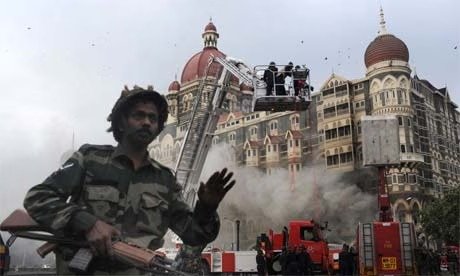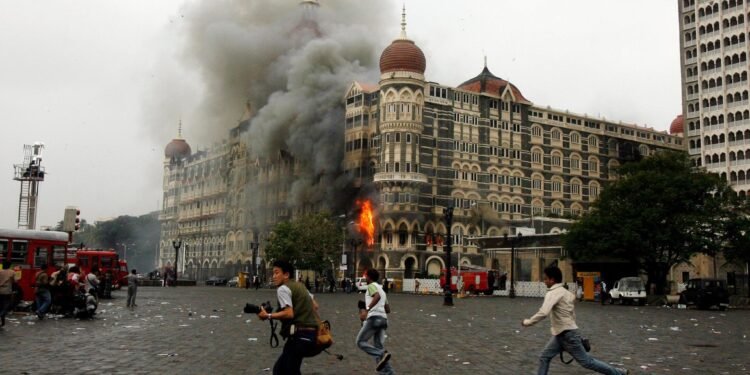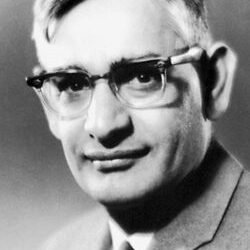Introduction
The 2008 Mumbai terror attacks, known as 26/11, unfolded from November 26 to 29, involving 10 Lashkar-e-Taiba (LeT) militants from Pakistan who executed 12 coordinated shootings and bombings across Mumbai, killing 175 people including 9 attackers and injuring over 300. Targeting high-profile sites like Chhatrapati Shivaji Terminus (CST), Leopold Cafe, Taj Mahal Palace Hotel, Oberoi Trident, and Nariman House (Chabad Center), the assault aimed to maximize casualties among Westerners, Jews, and Indians while drawing global attention. India’s response culminated in Operation Black Tornado by National Security Guard (NSG) Black Cats, who neutralized the terrorists after local police were overwhelmed, marking a pivotal counter-terror operation.

Planning and Infiltration
Preparation began months earlier in Pakistan, where LeT handlers trained the 10 young militants—mostly from Punjab—in camps near Muzaffarabad, teaching sea navigation, combat with AK-47s, RDX explosives, grenades, and GPS use. On November 21, they sailed from Karachi on a hijacked Pakistani boat, boarding Indian trawler MV Kuber on November 23, killing four crew except the navigator, whom they murdered near Mumbai coast before landing via inflatable dinghies at Badhwar Park around 8:10 PM on November 26.
Split into five teams of two, they carried GPS, satellite phones, BlackBerrys for handler contact, and provisions for days. Handlers in Karachi, including Zaki-ur-Rehman Lakhvi, directed via voice/video, prioritizing Western/Jewish targets to provoke India-Pakistan war and “liberate” Kashmir. Intercepts later revealed fanaticism: “Kill all hostages except two Muslims… Every individual you kill there [Nariman House] is like killing 50.”
Initial Attacks: Chaos at Key Sites
Attacks commenced around 9:20 PM. At Leopold Cafe, a Colaba hotspot for tourists/locals, two gunmen fired AK-47s, killing 10 and injuring dozens before fleeing, leaving blood-soaked floors. Simultaneously, at CST (Victoria Terminus), Asia’s busiest station, two militants sprayed bullets and lobbed grenades in the passenger hall, killing 58 and injuring 104 in minutes; they killed railway officials and escaped amid panic.
Taxi bombs detonated at Vile Parle and Mazagaon docks using RDX. Gunmen hit Cama Hospital, targeting staff/patients, killing three senior police including ATS chief Hemant Karkare, Additional CP Ashok Kamte, and encounter specialist Vijay Salaskar during a response. Nearby, St. Xavier’s College and Times of India lane saw firing. By 10 PM, Mumbai Police realized a multi-site siege; local forces, outgunned with pistols vs. automatic weapons, contained rather than neutralized.
Sieges at Luxury Hotels and Nariman House
Oberoi Trident (35 floors, business elite hub) saw two teams enter around 10 PM, killing 32 guests/staff, including nine in a restaurant; British businessman Tim Reed hid as gunmen passed feet away. Taj Mahal Palace, Mumbai’s iconic 1903 landmark hosting VIPs/presidents, burned from set fires; terrorists roamed corridors, killing selectively, marveling at “gold taps” per intercepts.
Nariman House (Chabad Jewish center) trapped Rabbi Gavriel Holtzberg, wife Rivka (six months pregnant), and others; two gunmen executed the couple and four hostages, prioritizing Jews as handlers urged: “Do it in the name of God.” By November 27 dawn, 74 dead, 300+ injured; media frenzy amplified terror, with Twitter/cell videos providing real-time intel but aiding handlers monitoring TV.
Security Forces Response: Delays and Local Efforts
Mumbai Police mobilized rapidly but suffered heavy losses—17 officers dead. Marine Commandos (MARCOs) arrived first at Taj/Oberoi, containing sites but lacking urban assault expertise. NSG Director General J.K. Dutt watched TV in Delhi, requesting deployment at 11:30 PM November 26; approval delayed till midnight due to air asset issues—no dedicated aircraft led to two IL-76 sorties (Manesar to Mumbai, 1000+ km).
First NSG batch (60 commandos) landed 4:30 AM November 27; full force (200+) by evening. Without floor plans, they improvised using hotel staff/room guides amid jammed doors requiring breaching charges. Rules: Minimize collateral, capture alive if possible, screen for disguised terrorists.
Operation Black Tornado: NSG Assault
Launched November 27, named for Black Cats’ uniforms/precision. At Oberoi (6:20 AM November 28), top-down sweep via service stairs cleared 547 rooms; cornered terrorists on 18th floor killed two after 8-hour gunfight/grenades; 143 rescued, 24 dead.
Nariman House assault (7:30 PM November 28): Heliborne fast-rope onto roof despite media leaks; suppressing fire/snipers cleared five floors, killing both terrorists; hostages dead earlier.
Taj, largest (560 rooms), toughest: Entered November 27 evening; room-by-room clearance took 60 hours amid fires/ambushes. Major Sandeep Unnikrishnan killed rescuing comrade; Hawaldar Gajender killed at Nariman. Final two terrorists neutralized 4:30 AM November 29 with rocket launchers/snipers; 200+ rescued.
Capture of Ajmal Kasab and Intelligence Breakthroughs
Sole survivor Ajmal Kasab captured alive November 26 at Girgaum Chowpatty by ASI Tukaram Omble, who grabbed his rifle bare-handed despite fatal wounds; Omble posthumously awarded Ashok Chakra. Kasab confessed LeT links, naming handlers; intercepts confirmed Pakistani control, foiling fidayeen (suicide) aims.
Casualties, Global Reaction, Legal Aftermath
Total: 175 dead (71 police/security/foreigners), 300+ injured; 9 terrorists killed, Kasab hanged November 21, 2012. Global outrage: Obama/Bush condemned; G8/UN pressed Pakistan, arresting Lakhvi briefly. India-Pakistan tensions peaked; dossier shared post-26/11 exposed ISI-LeT nexus.

Reforms and Legacy
Exposed urban terror gaps: NSG hubs created (Mumbai, Hyderabad); MAC (Multi-Agency Centre) for intel fusion; police modernization (better arms/training). 26/11 as “India’s 9/11” spurred counter-terror laws, resilience symbol—NSG’s 10:1 kill ratio hailed. Annual commemorations honor martyrs like Karkare, Unnikrishnan; underscores sea threat vigilance.




